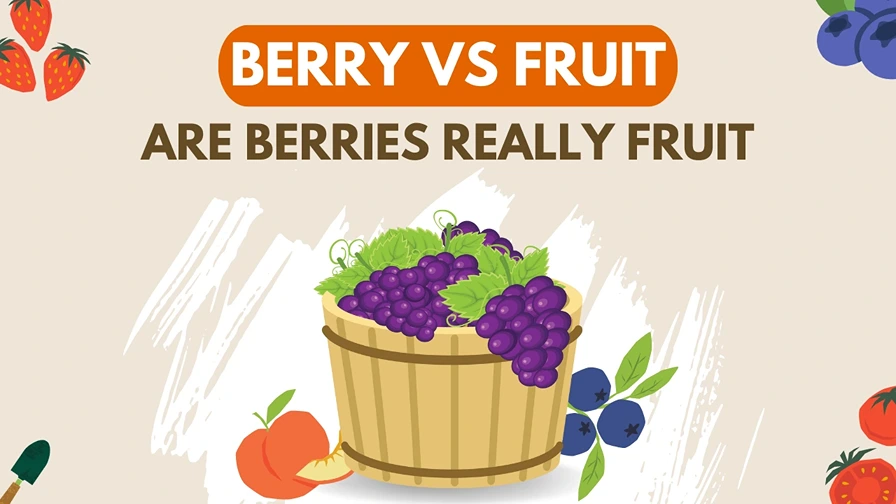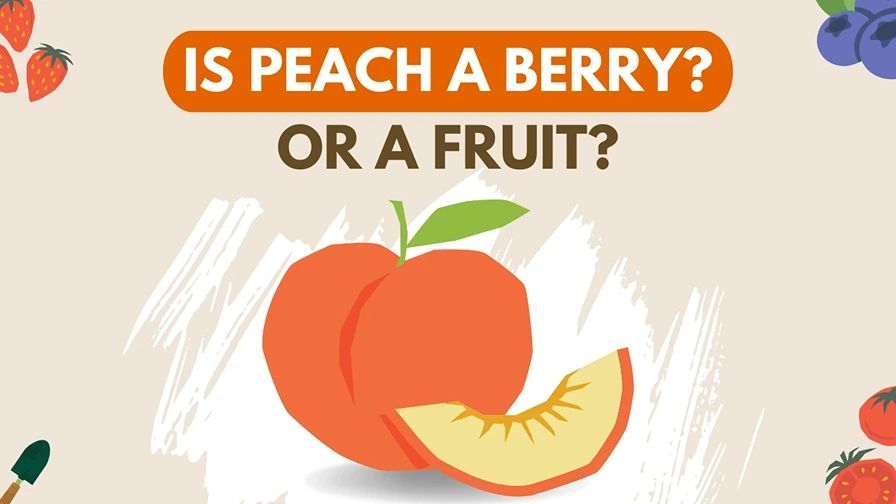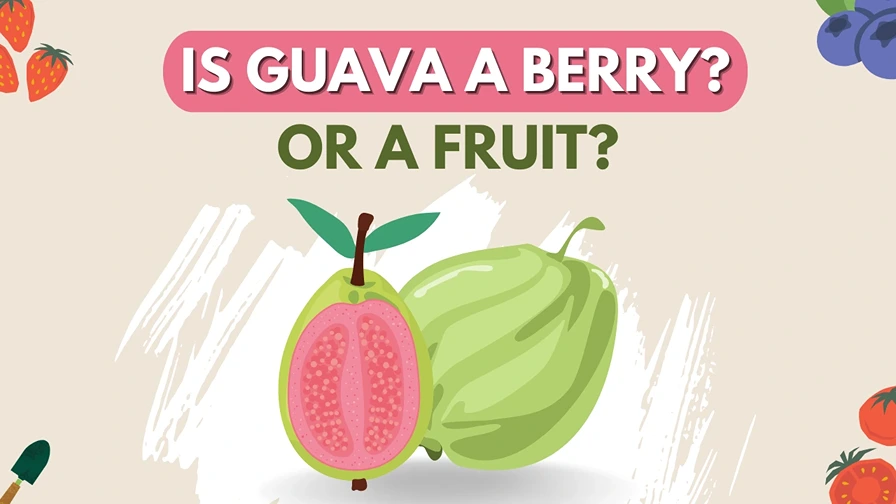Kiwifruit with its fuzzy brown exterior and vibrant green flesh, possesses a unique allure. The fruit having skin, flesh, and multiple seeds makes you wonder: Is kiwi a berry?
Yes, kiwi is a berry. The kiwifruit is classified as a true berry fruit.
But why kiwi is classified as a berry and not a citrus fruit (Hesperidium)? Let’s dive into the berry vs fruit debate and discover the wonders of the Kiwi fruit together.

Overview of The Kiwi Fruit
The kiwi fruit, with its distinctive appearance and tangy flavor, has captivated taste buds around the world.
Kiwi also known as the Chinese gooseberry, is a small, oval-shaped fruit that measures about the size of a chicken egg. Its most recognizable feature is its brown, fuzzy skin, which encases vibrant green flesh speckled with tiny black seeds.
Cutting open a kiwi reveals a soft, juicy interior with a refreshing and slightly tart taste. The fruit’s texture is often compared to that of a strawberry, while its flavor has hints of citrus and tropical notes.
Brief History and Origin
Although the kiwi fruit is now enjoyed worldwide, its journey began in China, where it was originally called the Chinese gooseberry.
In the early 20th century, seeds from the kiwi fruit were brought to New Zealand, where they thrived in a favorable climate and fertile soil. New Zealand recognized the fruit’s potential and began cultivating it on a larger scale.
Eventually, the fruit’s name was changed to kiwi, inspired by New Zealand’s national bird, which also has a fuzzy exterior.
Versatility and Culinary Uses
The kiwi fruit’s unique flavor and texture lend themselves to a wide range of culinary applications. Its vibrant color and refreshing taste make it a popular ingredient in fruit salads, smoothies, and desserts.
Sliced kiwi can be used to garnish cakes, tarts, or yogurt bowls, adding a touch of visual appeal and tangy sweetness. Additionally, kiwi fruit can be incorporated into savory dishes, such as salads or salsa, to provide a contrasting burst of flavor.
Nutritional Value
Apart from its delightful taste, kiwi fruit packs a nutritional punch. It is an excellent source of vitamin C, providing more than twice the recommended daily intake in just one medium-sized fruit.
Kiwi also contains dietary fiber, aiding in digestion, and is rich in antioxidants, which help protect against oxidative stress. Furthermore, it is a good source of vitamins E and K, as well as potassium and folate.
Understanding Fruit Classification
Fruit classification is the process of categorizing fruits based on their botanical characteristics, structure, and other defining attributes. It serves several purposes, including facilitating scientific research, aiding in agricultural practices, and providing consumers with information about different fruits.
By classifying fruits, botanists, and researchers can better understand the relationships between different plant species and their reproductive structures. This knowledge helps in areas such as plant breeding, genetic studies, and understanding the ecological roles of fruits in nature.
For farmers, fruit classification provides valuable insights into optimal cultivation methods, as different fruits have varying requirements for soil, water, and climate. It helps farmers make informed decisions about planting, harvesting, and crop management practices.
Types of Fruits
Fruits can be classified into various categories based on their botanical characteristics and attributes. Some common categories include berries, citrus fruits, pomes, and drupes. Each category has distinct features that set it apart from others.
- Berries: Berries are fruits that grow from a single ovary of a flower and typically have a fleshy pericarp (the part surrounding the seed) and multiple seeds. Examples of berries include strawberries, blueberries, and raspberries.
- Citrus Fruits: Citrus fruits belong to the Rutaceae family and are characterized by their leathery rind and juicy carpel segments. Oranges, lemons, and grapefruits are all examples of citrus fruits.
- Pomes: Pomes are fruits that have a central core containing seeds surrounded by a fleshy receptacle. Apples and pears are classic examples of pome fruits.
- Drupes: Drupes, also known as stone fruits, have a single seed surrounded by a hard shell or stone. Peaches, plums, and cherries are examples of drupe fruits.
Examining Kiwi as a Berry
To determine whether the kiwi fruit can be classified as a berry, let’s explore the characteristics of berries and examine how the kiwi fruit aligns with these traits.
Definition of Berry
Berries grows from a single ovary of a flower. It is a type of fruit that has fleshy pulp with a soft pericarp (the part of the fruit that surrounds the seed) that is often juicy and edible.
Berries typically contain multiple seeds, distributed throughout the fruit’s flesh. They come in various colors, including red, blue, purple, and black, and can range in size from small to medium.
One defining feature of berries is their fleshy pericarp, which is derived from the ovary of the flower. This pericarp is often soft, making berries juicy and enjoyable to eat.
The multiple seeds found within berries are usually small and dispersed throughout the flesh, rather than concentrated in a central core.
Examples of berries include blueberries, grapes, cranberries, blackcurrants, etc.
Characteristics of Berries
Berries are a category of fruits that possess specific characteristics that distinguish them from other fruit types. Some key traits of berries include:
- Single Ovary: A berry grows from a single ovary of a flower.
- Fleshy Pericarp: Berries have a fleshy pericarp, which refers to the part of the fruit that surrounds the seed. This fleshy layer is typically soft and juicy.
- Multiple Seeds: Berries usually contain multiple seeds embedded within the fleshy pericarp. These seeds are distributed throughout the fruit.
Is Kiwi a Berry?
Now, let’s examine how the kiwi fruit aligns with these berry characteristics:
- Single Ovary: Kiwi fruit also grows from a single ovary of a flower similar to berries.
- Fleshy Pericarp: The kiwi fruit possesses a fleshy pericarp, with its soft and juicy green flesh enveloping the seeds. When you bite into a kiwi, you can experience a burst of juiciness, similar to other berries.
- Multiple Seeds: Kiwi fruit is speckled with numerous small black seeds, dispersed throughout its flesh. This characteristic aligns with the presence of multiple seeds commonly found in berries.
Based on these characteristics, the kiwi fruit shares several similarities with berries. It grows from a single ovary of a flower, possesses a fleshy pericarp, and has multiple seeds aligned with the characteristics of berries.
While the kiwi fruit exhibits these traits, it is essential to consider other factors before concluding whether it can be definitively classified as a berry.
So let’s explore if Kiwi can be classified as a Citrus fruit.
Evaluating Kiwi as a Citrus Fruit
There is confusion around the Kiwi fruit and whether it can be classified as a citrus fruit or not. By examining the characteristics of citrus fruits and comparing them to the attributes of the kiwi fruit, we can assess its suitability for this classification.
Definition of Citrus Fruit
Citrus fruits are a specific category of fruits that belong to the Rutaceae family. They are known for their distinctive characteristics, including their leathery rinds, juicy segments, and tangy flavors. Citrus fruits are widely recognized for their high content of vitamin C and are valued for their refreshing qualities.
One defining feature of citrus fruits is their leathery rind, which protects the juicy segments within. The rind can vary in thickness and texture, ranging from smooth to bumpy or textured.
Citrus fruits have a unique structure where the fruit is divided into individual segments or vesicles that contain the juice. These segments are typically easy to separate, making citrus fruits enjoyable to eat.
The flavor profile of citrus fruits is often described as tangy and refreshing, with varying degrees of tartness. They can range from sweet to sour, with some varieties offering a perfect balance between the two.
Some well-known citrus fruits include oranges, lemons, limes, grapefruits, tangerines, and mandarins. They are prized for their nutritional value, particularly their high vitamin C content, which supports immune health and overall well-being.
Citrus fruits are recognized for their unique combination of leathery rinds, juicy segments, tangy flavors, and nutritional benefits, making them a beloved category of fruits.
Characteristics of Citrus Fruits
Citrus fruits are a distinct category of fruits known for their specific characteristics. Some key traits of citrus fruits include:
- Leathery Rind: Citrus fruits have a thick and leathery rind that surrounds the juicy segments within. The rind is often textured and can be peeled or segmented.
- Juicy Segments: Citrus fruits are composed of juicy segments or vesicles that contain the fruit’s juice. These segments are typically organized into sections or wedges.
- Tart and Tangy Flavor: Citrus fruits are known for their characteristic tart and tangy flavor profile. They often possess a refreshing acidity that adds a zing to culinary preparations.
- High Vitamin C Content: Citrus fruits are renowned for their high vitamin C content, making them a popular choice to boost immune health and overall well-being.
Is Kiwi a Citrus Fruit?
Now, let’s evaluate how the kiwi fruit aligns with the characteristics of citrus fruits:
- Leathery Rind: Unlike citrus fruits, the kiwi fruit has a thin, brown, and slightly fuzzy skin. Its skin is not leathery like that of oranges or lemons, but rather smooth and easy to peel.
- Juicy Segments: While citrus fruits have distinct segments or wedges, the kiwi fruit has soft and uniformly textured flesh, without the defined segments observed in citrus fruits.
- Flavor: The kiwi fruit’s flavor profile is slightly tart, but it also has tropical and sweet notes. While it shares some tanginess with citrus fruits, its overall flavor profile is distinct.
- Vitamin C Content: While kiwi fruit is a good source of vitamin C, its vitamin C content is not as high as that found in citrus fruits.
Based on these characteristics, the kiwi fruit does not align closely with the typical attributes of citrus fruits. Its skin is not leathery, it lacks defined segments, and its flavor profile is more varied. While the kiwi fruit shares some tanginess and contains vitamin C like citrus fruits, it diverges in other key aspects.
The Verdict: Kiwi is a Berry
After examining the characteristics of the kiwi fruit and comparing them to the traits of both berries and citrus fruits, it is evident that the kiwi fruit aligns more closely with the botanical definition of a berry rather than citrus fruit.
Let’s summarize what makes kiwi a berry and not a citrus fruit.
Kiwi is a Berry:
- Kiwi fruit has a fleshy pericarp, making it juicy and edible like other berries.
- It contains multiple seeds dispersed throughout its flesh, a characteristic of many berries.
- The size of the kiwi fruit falls within the typical range of berries.
Kiwi is Not a Citrus Fruit:
- Kiwi lacks a leathery rind, which is a distinguishing feature of citrus fruits.
- Its brown, fuzzy skin is different from the smooth and thick rinds of citrus fruits.
- The kiwi fruit’s unique combination of textures and tropical flavors sets it apart from the characteristics of citrus fruits.
Based on its characteristics, we can clearly state: Kiwi is a berry. Its fleshy pericarp, multiple seeds, and small size align with the traits of berries.
While kiwi may share some flavor elements with citrus fruits, its distinct features differentiate it from the typical attributes of citrus fruits. Therefore, kiwi is not a citrus fruit.
How Kiwi Fruit Grows
Understanding how kiwi fruit grows can provide insights into its unique characteristics and cultivation requirements. Let’s explore the growth process of kiwi fruit, from pollination to ripening.
- Pollination and Flowering
Kiwi fruit plants are dioecious, meaning they have separate male and female plants. Female plants produce edible fruits, while male plants produce pollen. To ensure fruit development, both male and female plants need to be present in the vicinity.
During the spring season, kiwi plants produce clusters of small, creamy-white flowers. Male flowers contain pollen-producing stamens, while female flowers have a central pistil. Insect pollinators, such as bees, play a crucial role in transferring pollen from male to female flowers.
- Fruit Formation and Maturation
Once pollination occurs, the fertilized flowers begin to develop into fruit. The tiny fruit, called an embryo, starts to grow and undergoes cell division, expanding in size. Over time, the fruit undergoes various stages of development.
As the kiwi fruit matures, it undergoes changes in color, texture, and flavor. The green flesh gradually transforms into its characteristic vibrant green or golden color, depending on the kiwi variety. The fruit becomes plump and slightly soft to the touch.
- Harvesting and Storage
Kiwi fruit is typically harvested when it reaches its optimal stage of maturity. This is determined by factors such as fruit size, color, and firmness.
Harvesting too early may result in underdeveloped flavor and texture, while harvesting too late may lead to overripeness and loss of quality.
After harvest, kiwi fruit can be stored for a certain period. Proper storage conditions, such as cool temperatures and controlled humidity, help to maintain the fruit’s quality. Kiwis are often stored in refrigerated conditions to prolong their shelf life and preserve their flavor and texture.
- Cultivation Requirements
Kiwi fruit cultivation requires specific environmental conditions to thrive. These include:
- Climate: Kiwi fruit thrives in temperate climates, with cool winters and warm summers. It requires a certain number of chilling hours during winter to break dormancy and initiate spring growth.
- Sunlight: Kiwi plants need ample sunlight to support fruit development. They prefer a sunny location that receives at least six to eight hours of direct sunlight each day.
- Soil: Well-drained soil rich in organic matter is ideal for kiwi cultivation. The soil should have good water-holding capacity to ensure adequate moisture for the growing plants.
- Support Structure: Kiwi plants are vigorous climbers and require a sturdy support structure, such as a trellis or arbor, to support their growth. The support structure helps keep the vines off the ground, facilitates fruiting, and eases harvesting.
By understanding the growth process of the kiwi fruit and its cultivation requirements, we can appreciate the care and considerations involved in producing these delicious and nutritious fruits.
Conclusion
The kiwi fruit is classified as a berry. Its fleshy pericarp, multiple seeds, small size, and overall resemblance to other berries position it firmly within the berry category.
While the kiwi fruit may share certain flavor elements with citrus fruits, its distinctive features, such as the absence of a leathery rind and its unique tropical flavor profile, differentiate it from the typical traits of citrus fruits.
Therefore, when considering the question of whether is kiwi a berry or a citrus fruit, the answer comes as kiwi is a berry.




